Quick Summary
- Ensure your fence is at least six feet tall (particularly for larger breeds)
- Prevent digging with an L-footer or concrete footer
- Add strong locks to doors and gates
- Prevent larger dogs from climbing with a smooth fence or fence roller
- Add dense bushes at the base of fences to prevent your dog from getting close
- Add a lean-in to discourage expert climbers
- Block vision for reactive dogs with bamboo rolls or reeds
- Remove objects that could allow a dog to climb or jump
- Supervise your dog and give them lots of attention in the yard
An escaped dog is a danger to both itself and others. Aside from getting lost, a loose dog could be hit by a car, attacked, bite a human, or even be stolen. Sadly, many dog owners find out too late their garden isn’t as secure as they thought.
To help keep your pet safe, here are nine methods for dog-proofing a fence, along with tips from IMDT dog trainer Rebecca Morello. But before we get to the tips, it’s important to understand how your dog might escape and why they might try to do so.
Covered In This Article
The (Many) Ways a Dog Can Escape a Fence
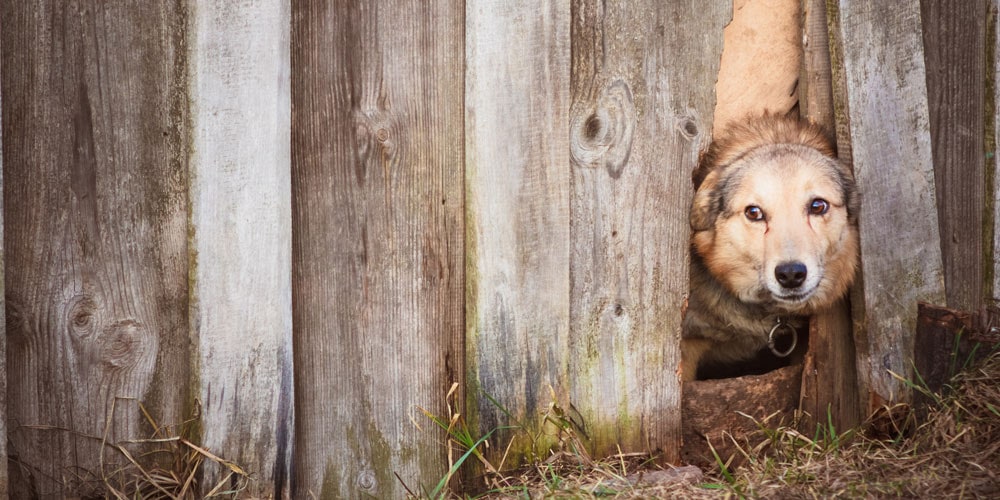
Dogs are athletic and intelligent animals. There are many ways they can break out of a yard that appears to be secure, so it’s important to be aware of these potential escape tactics.
“The most common escape tactics depend on the dog’s breed,” says Rebecca Morello, IMDT dog trainer. “Breeds bred to hunt underground, such as terriers and Dachshunds, will often use their digging skills. Tiny dogs may even be able to squeeze through gaps, especially puppies, due to the flexibility of their cartilage.”
The easiest way to escape is through a gap or hole in the fence. These weaknesses need to be fixed immediately, as once your pet has found them, they are unlikely to forget. But assuming your fence isn’t damaged, here are some of the most common escape methods.
1. Brute Force
A powerful dog may break through a fence – especially if they are distressed by something on the other side or have separation anxiety.
This is most common with wire fences. If your dog can get their mouth partially through one of the spacings, they could rip or bend the wire enough to escape. The most powerful and determined dogs may also try to break through wooden fence slats, although this is less likely.
2. Finding Creative Escape Routes
Clever dogs often find creative ways to escape a yard. For example, they might learn to open latches – especially after watching you open the gate a few times – or climb an angled tree to jump a fence.
I’ve even seen dogs move garden furniture closer to a fence for an easier jump!
It’s important to understand that this isn’t a dog being “sneaky” and they can’t plan in advance. But many dogs are intelligent, so they can come up with creative ideas if they want to climb a fence.
3. Digging Under the Fence
Digging is a common way for a dog to escape a fence. Hounds and terriers are usually the culprits, as they are natural diggers, but almost any dog can develop a digging habit.
Just because your dog isn’t alone for long periods doesn’t mean they can’t dig a tunnel. They may return to a hole multiple times over several days, until it’s finally possible to escape.
Unfortunately, it’s difficult to discourage digging if it’s an instinctive behavior. Instead, you need to ensure your pet can’t dig an escape route.
Note: We’ve also written a guide to preventing digging, although this focuses on management strategies as it’s hard to teach a dog to not perform an instinctual behavior.
4. Jumping Over the Fence
Dogs can jump surprisingly high. Breeds such as the German Shepherd, Siberian Husky, and Bull Terriers can leap a four foot picket or wrought iron fence whilst barely breaking stride.
Some smaller dogs, such as the Jack Russell, are also known for their leaping ability. A dog’s size isn’t always a reliable indicator of their jumping height!
5. Climbing The Fence
Dogs aren’t usually associated with climbing – but many can climb a wire fence if they feel driven to escape.
While most find this difficult, I’ve seen some dogs scale chain link fences with a spider-like speed. So climbing isn’t an escape method that can be ignored.
Why Dogs Try To Escape
Before dog-proofing your fence, it’s vital to understand why your dog is trying to escape.
In some cases, your dog’s attempts to climb or dig under the fence could be a symptom of an underlying problem. “It is very important to understand that if escape attempts are caused by stress or anxiety, the dog will still feel these emotions even with an escape-proof yard,” says Morello.
Understanding what’s driving escape attempts can also make it easier to fix the issue. For example, if visual triggers cause escape attempts, blocking your dog’s vision may make them less likely.
Some common reasons for a dog trying to escape include:
- Curiosity – some dogs just want to see what’s on the other side of the fence or explore a new area.
- Looking for a mate – the drive to find a mate can be a strong motivator for a dog to escape the garden.
- Lack of stimulation (boredom) – dogs who aren’t receiving enough mental and physical stimulation are more likely to try and escape.
- Separation anxiety – dogs suffering from separation anxiety may try to escape to find their owner.
- Reactivity – dogs who are reactive to people, other dogs, or something else may try to escape if they see a trigger. If this sounds like your dog, you’ll need to reduce visibility through the fence so they don’t get stressed (or annoy the neighbors with constant barking!)
If your dog is repeatedly trying to escape, then it’s a good idea to contact a canine behaviorist. They will be able to help you understand and address the underlying problem.
Warning: Tethering a dog isn’t a solution to escaping. Being tethered for long periods is frustrating and stressful, and can lead to long-term psychological issues. It can also be dangerous if the leash gets caught around the neck or limbs.
It’s Not Just Escaping That’s The Problem…
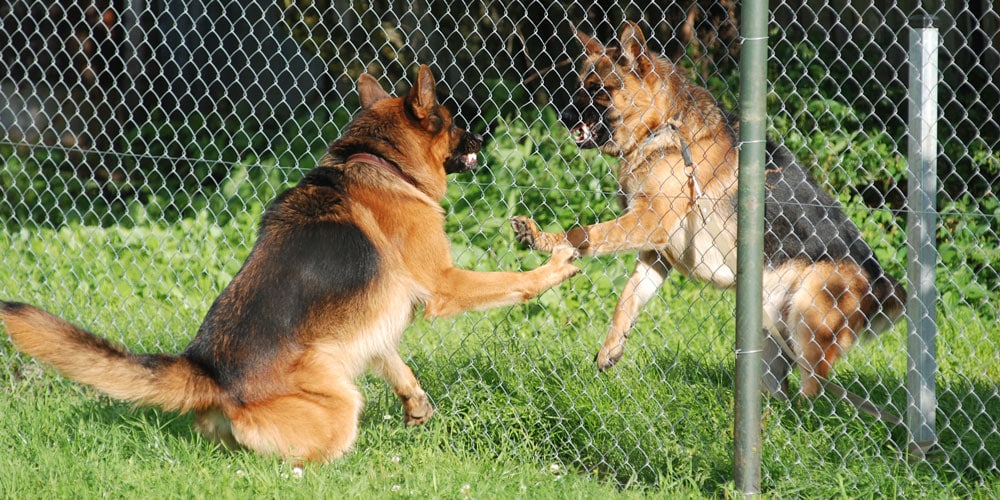
Keeping your dog safely inside a fence is the primary goal. But you also need to consider how they react to people and animals on the other side.
Many dogs get stressed if they see a person, dog, or animal, but can’t get to it. This can lead to barking, growling, or air snapping, in what’s known by dog trainers as “fence reactivity.”
In the worst cases, a dog may get so desperate that they injure themselves in the process of trying to escape.

The Dangers of an Escaped Dog: A Trainer’s Story
“Once during my time training guide dogs, I was taking Mr Bill (a beautiful golden retriever) through the local town center. We passed a black iron gate with three small terriers barking at him.”
“Mr. Bill was amazing and carried on walking despite the distraction. However, one of the terriers managed to squeeze themselves through the iron bars, which gave confidence to the others to do the same. At this point they all charged at Mr Bill, nipping his legs and hanging off his tail. The dogs’ guardians were nowhere to be seen as they hadn’t even realized it was happening!”
“Once I had managed to distract them away from Mr Bill, they all ran into traffic on the road! Luckily a kind member of public helped me and went to speak to the family who managed to get the terriers back inside. Mr. Bill was not physically hurt but it took him weeks to regain his confidence.”
“The end result could have been much worse for both the terriers and Mr Bill, which shows how important it is to dog-proof your garden.”
9 Tips for Dog Proofing Your Fence
Once you know how your dog is likely to escape, it’s important to fix any weaknesses in your fence. Here are nine tips for keeping your pet safe and secure.
1. A Six Foot Tall and Sturdy Fence is the Minimum for Most Dogs

A four-foot fence just isn’t enough to contain a dog that wants to jump. I recommend fences at least six feet tall, as this is enough to stop most dogs jumping. Extra height also discourages climbing.
Height isn’t the only factor though – strength also matters. Strong dogs can rip thin wire fencing or batter down weak wooden joints. Here are the options to consider:
- For weld wire fencing, 14 gauge provides a balance between strength and price – at least for less powerful breeds. 16 gauge is too weak, while the cost of 12 gauge means a chain link fence is a better option.
- Stronger chain link fencing also has various gauge options, with most being suitable for larger breeds. It’s not the most attractive type of fence, but it is strong, affordable, and durable.
- Wrought iron fences are very strong, but are expensive and difficult to install. They may also have gaps between bars that a dog can put his head through.
- Privacy fences are opaque and usually made from wood or vinyl. They can discourage escape attempts, as they are difficult to climb and don’t allow your dog to see what’s on the other side. They aren’t as strong as chain link or wrought iron fences though.
It’s essential that a reactive dog can’t get their head through the slats or gaps between wires. Aside from getting his head stuck, gaps that are too large could allow them to bite (or get bitten).

A Word About Picket Fences…
While a short picket fence might look great, and is probably fine for a calm and small dog, it isn’t going to stop an escape-prone canine.
Another problem with picket fences is the large gaps can allow a dog to get his jaws through. If your pet is fence reactive, these gaps could allow an overstimulated dog to grab a person or other dog through the fence.
2. Prevent Digging With an L-Footer or Concrete Footer
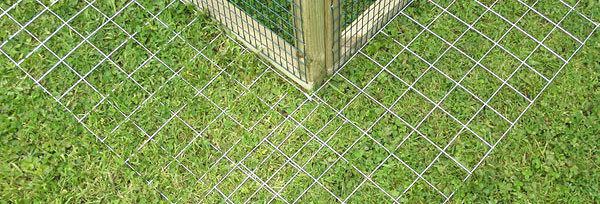
An L-Footer is wire fencing that’s placed at the base of your existing fence. It should be laid at a 90-degree angle.
The great thing about an L-Footer is that it prevents digging without the need for a trench. You can also cover it with rocks or plant pots to make it more aesthetically pleasing.
L-Footers might not be enough for the most determined diggers though. For these dogs, you may need to pour a cement footer and install the fence poles before it dries. This is expensive and time-consuming, but highly effective.
An alternative is to dig a trench and install a secondary fence underground. Again, this is time-consuming, but can stop escapes without concrete.
3. Strong Locks to Protect Doors and Stop Accidental Escapes
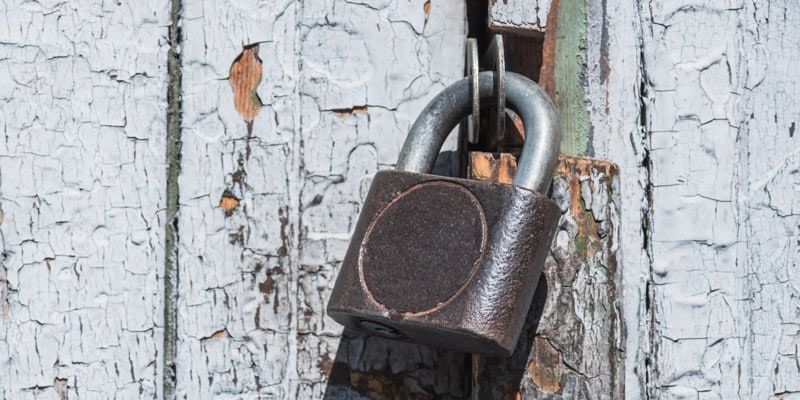
You can have the tallest, strongest fence in the world…but it’s useless if the gate blows open whenever there’s a strong wind (or if your dog works out how to unlatch it!)
For this reason, buy a strong internal lock to keep the gate shut.
4. Prevent Climbing with a Smooth Fence or Fence Roller

One of the best ways to prevent climbing is a fence with a smooth surface. For example, privacy fences made from vinyl or wood are much more difficult to climb than chain link.
If this isn’t an option, a fence roller can help. These are long cylinders that are fixed at either end, but can rotate freely so the dog can’t grip them.
5. Landscaping Can Be Your Friend
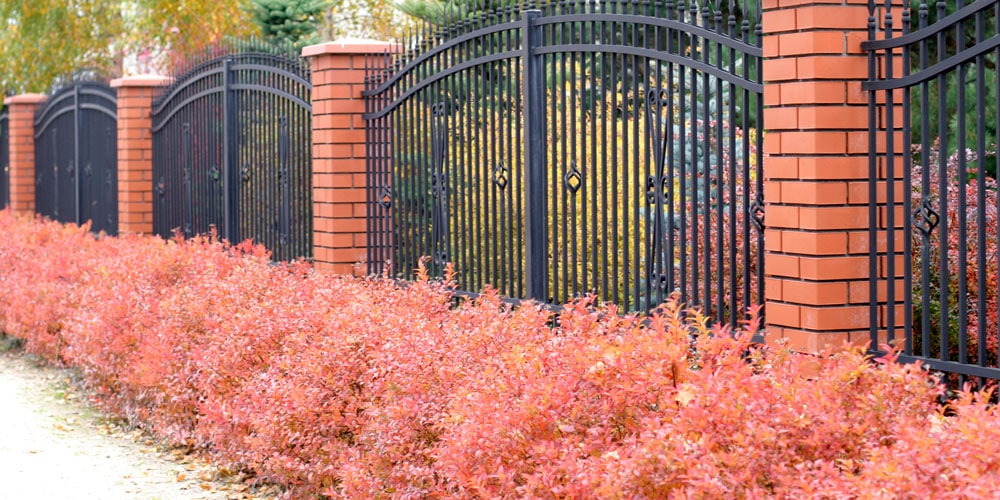
Planting dense bushes and shrubs around the perimeter can stop your dog from getting close to the fence. This has the dual benefit of making jumping and climbing more difficult, while also obscuring their vision.
Another advantage of shrubbery is that it can prevent patrolling. This can become an obsessive behavior for some dogs, but is much less rewarding if they can’t get close to the fence.
Be aware that some plants and shrubs are poisonous to dogs though. Dogs Trust in the UK has a useful list.
A more extreme technique is to install a secondary fence. This should be placed a short distance inside the main fence, to discourage jumping, climbing and patrolling. The downside is that you’ll lose space in your garden.
6. Add a Lean-In to Discourage Climbing

A lean-in is a section of fence angled inwards or horizontally. As you can imagine, this makes it virtually impossible for a dog to climb out.
The downside is that it can make your yard look more like a prison than a home. If you’re desperate to stop your climbing pup, however, it’s one of the most effective options. It’s also useful if your local housing regulations limit fence height.
For the ultimate climbing dogs, a full mesh roof could be the safest option. This is unattractive and usually unnecessary for a domestic dog, but is common in shelters.
7. Block Vision with Reed or Bamboo Rolls
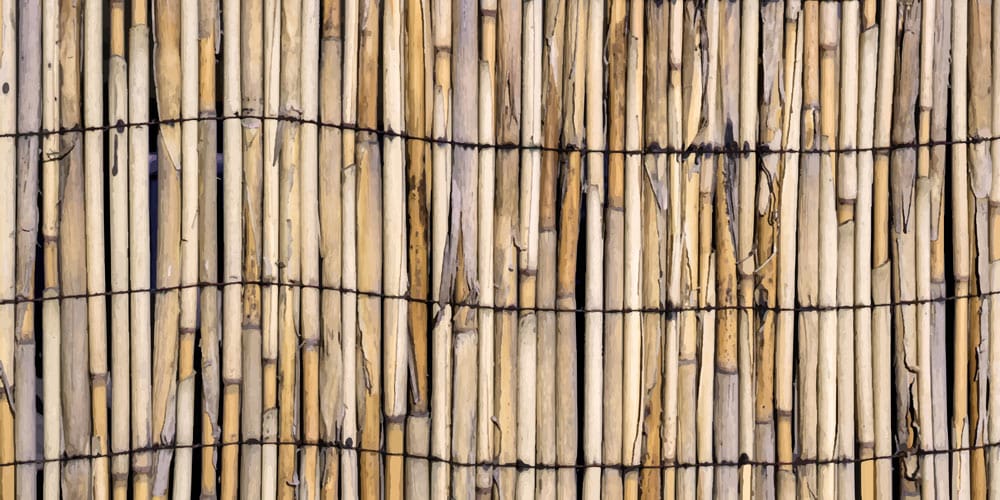
If your dog is “fence reactive” or just loves to bark at anything he sees, it’s important to block their vision. While a full privacy fence is the best way to do this, bamboo or reed rolls can be an inexpensive alternative for a chain link fence.
These rolls are zip-tied to the chain links to reduce visibility. It won’t stop all light from penetrating, but it can make it less likely your dog will see squirrels, people, or other dogs.
Rolls are available in several heights, so make sure you get one that’s big enough for your dog. Reed is cheaper, but bamboo is more durable.
Of course, fence reactivity isn’t something that should be ignored, so rolls should only be a temporary solution. Desensitization training is vital for teaching your dog how to behave when they see a person or dog through the fence.
8. Remove Anything That Could Help a Dog Jump or Climb

Dogs can be surprisingly resourceful when they want to escape. Even a small object could provide just enough extra height to allow your pet to jump the fence.
The key is to remove or secure anything that could be used by an escape-prone pup. This includes garden furniture, log piles and dog houses. You should even look out for slanted tree trunks, as these could be climbed for extra height.
“Make sure you check every fence panel, gate, and wall in the garden – and don’t overlook those areas with thick hedges that a determined dog could push through,” adds Morello. “Check for holes, gaps, loose parts, or furniture nearby that could help them get a leg up.”
9. Supervision is the Ultimate Dog-Proofing Tip

If a dog loves to escape, supervising them in the yard is always the best (and cheapest) option. Escape attempts are often the result of boredom or frustration, so just playing with your dog outside could help.
“The best way to make a yard more engaging is accompanying your dog outside and being actively involved,” says Morello. “Dogs are social creatures and we have bred them to be dependent on us for attention and affection, which you can never give enough of!”
This isn’t always possible though. We all have times when we need to let the dog out for the toilet or to give them some extra outdoor time after a shorter walk, which is why dog-proofing is essential.
Providing more mental stimulation in the backyard may also help. For example, a sand pit or soil box could be a place for your dog to dig without destroying the garden or escaping. You may also want to consider a GPS tracker for your pet – at least as a backup plan – as these gadgets make it easier to find a lost dog.

Why I Don’t Recommend Invisible Fences
Invisible dog fences are sometimes recommended for preventing escapes. They are essentially shock collars that are activated when your dog goes near a buried wire (there are also wireless alternatives).
I have several issues with this method. Firstly, at The Dog Clinic we never condone using a device that causes a dog pain. While the dog may learn to fear the boundary edge, this is the result of numerous electric shocks, which is unnecessarily cruel.
For this reason, I don’t recommend an “invisible fence” on ethical grounds alone.
There’s another problem though. An electric fence is not a reliable way to stop a dog escaping, as strong emotions (such as fear, frustration or aggression) can override the pain.
If a dog sees something it wants to chase, it may run through the electric shock in its excitement. When it calms down, the dog is now trapped outside the yard. An invisible fence also won’t stop other dogs, animals and people from entering the yard – it only tries to stop your dog getting out.
Summary
A dog proof fence is essential for your pet’s safety. Whether your pup digs, climbs, or jumps, fixing fence weaknesses is an urgent task.
It’s also essential to understand why your dog is trying to escape. If this behavior is caused by stress, anxiety, or reactivity, then addressing the underlying problem is vital.
Do you have any questions about how to dog proof a fence? Please let me know in the comments section below. You may also want to read our guide to dog-proofing your home.




